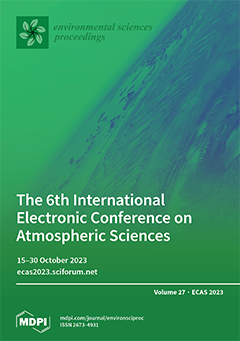On the basis of a long-term analysis (2013–2021), we report the inter-annual and seasonal concentrations and possible sources of trace elements (TEs) in PM
2.5 over Delhi, India. In all the PM
2.5 samples, 19 major and trace elements were extracted: Na, Al,
[...] Read more.
On the basis of a long-term analysis (2013–2021), we report the inter-annual and seasonal concentrations and possible sources of trace elements (TEs) in PM
2.5 over Delhi, India. In all the PM
2.5 samples, 19 major and trace elements were extracted: Na, Al, Fe, Ti, Mg, Cu, Zn, Cr, Mn, Ni, As, Mo, Cl, P, S, Ca, K, Pb, and Br. The total annual mean concentration (∑El in PM
2.5) of major and trace elements was 17.4 ± 3.1 µg m
−3, accounting for 13.9% of PM
2.5. The enrichment factor (EF) and IMPROVE model analysis indicate the seasonal abundance of mineral/soil dust (Fe, Al, Ti, Na, Ca, and Mg) at the sampling location of Delhi. During the sampling period, the highest loading of trace elements was recorded in 2015 (19% of PM
2.5) and the lowest in 2020 (9% of PM
2.5), possibly due to limited activity during COVID-19 lockdown/unlock times. The major sources of elements (in PM
2.5) were extracted by a principal component analysis (PCA) as crustal/soil/road dust, vehicular traffic/industrial emissions, combustion (solid + fossil fuels), and sodium magnesium salts in Delhi.
Full article



